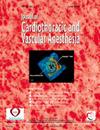Safety of Transesophageal Echocardiography in Patients Referred for Tricuspid Valve Disease at a Center for Structural Heart Disease
IF 2.3
4区 医学
Q2 ANESTHESIOLOGY
Journal of cardiothoracic and vascular anesthesia
Pub Date : 2025-02-26
DOI:10.1053/j.jvca.2025.02.041
引用次数: 0
Abstract
Objectives
The aim of this study was to examine safety outcomes in patients referred for transesophageal echocardiograms (TEEs) for tricuspid valve disease.
Design
Retrospective observational study.
Setting
Single quaternary referral center specializing in structural heart disease.
Participants
One hundred five patients referred for TEE for tricuspid valve disease between July 2022 and June 2023.
Interventions
This study was not interventional, but assessed the safety of TEE.
Methods and Main Results
The primary outcome was a composite of hypotension (mean arterial pressure [MAP] < 60 mmHg); use of epinephrine, norepinephrine, or calcium chloride; aborted studies due to documented clinical instability; emergent intubation; hospitalization or escalation of care post-TEE; oropharyngeal or gastrointestinal injury; or cardiac arrest. Secondary outcomes were 30-day cardiovascular mortality, all vasopressor use, and time spent per TEE. The primary outcome was noted in 32 patients (30.5%). The rate of cardiac arrest was 2.9% (3/105). Hypotension (MAP < 60 mmHg) was noted in 30 patients, with 7 patients needing hospitalization after TEE. No patients had oropharyngeal or gastrointestinal injury. There was a greater prevalence of moderate to severe right ventricular (RV) dilation (77% vs 53%; p = 0.022) and moderately to severely decreased RV function (48% vs 25%; p = 0.023) in patients who met the primary outcome. Both RV fractional area change (37.9% vs 29.8%; p = 0.003) and tricuspid annular plane systolic excursion (1.84 cm vs 1.45 cm; p = 0.002) were lower on baseline transthoracic echocardiogram.
Conclusions
Patients with severe tricuspid regurgitation had a high prevalence of adverse events when undergoing TEE. Further studies are needed to compare these outcomes with other groups undergoing diagnostic TEE and delineate what risk factors may place these patients at greater risk.
结构性心脏病中心经食管超声心动图对三尖瓣疾病患者的安全性
目的:本研究的目的是检查三尖瓣疾病患者经食管超声心动图(tee)的安全性结果。设计:回顾性观察性研究。设置:单一的四级转诊中心,专门从事结构性心脏病。参与者:在2022年7月至2023年6月期间,有105名患者因三尖瓣疾病转介TEE。干预措施:本研究不是干预性的,但评估了TEE的安全性。方法和主要结果:主要结局为低血压(平均动脉压[MAP] < 60 mmHg);使用肾上腺素、去甲肾上腺素或氯化钙;因临床不稳定而中止的研究;紧急插管;tee后住院或护理升级;口咽或胃肠损伤;或者心脏骤停。次要结局是30天心血管死亡率、所有血管加压药物的使用和每次TEE的时间。32例患者(30.5%)出现主要结局。心脏骤停发生率为2.9%(3/105)。30例患者出现低血压(MAP < 60 mmHg), 7例患者TEE后需住院治疗。无患者出现口咽或胃肠道损伤。中度至重度右心室(RV)扩张的患病率更高(77% vs 53%;p = 0.022)和中度至重度右心室功能下降(48% vs 25%;P = 0.023)。两个RV分数面积变化(37.9% vs 29.8%;P = 0.003)和三尖瓣环面收缩偏移(1.84 cm vs 1.45 cm;P = 0.002)均低于基线经胸超声心动图。结论:严重三尖瓣反流患者接受TEE治疗时不良事件发生率高。需要进一步的研究将这些结果与其他接受诊断性TEE治疗的组进行比较,并描述哪些风险因素可能使这些患者处于更大的风险中。
本文章由计算机程序翻译,如有差异,请以英文原文为准。
求助全文
约1分钟内获得全文
求助全文
来源期刊
CiteScore
4.80
自引率
17.90%
发文量
606
审稿时长
37 days
期刊介绍:
The Journal of Cardiothoracic and Vascular Anesthesia is primarily aimed at anesthesiologists who deal with patients undergoing cardiac, thoracic or vascular surgical procedures. JCVA features a multidisciplinary approach, with contributions from cardiac, vascular and thoracic surgeons, cardiologists, and other related specialists. Emphasis is placed on rapid publication of clinically relevant material.

 求助内容:
求助内容: 应助结果提醒方式:
应助结果提醒方式:


